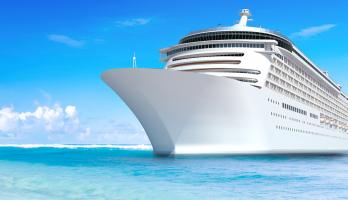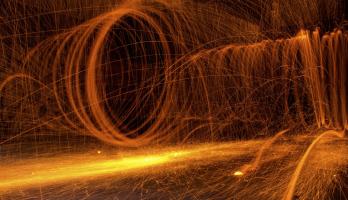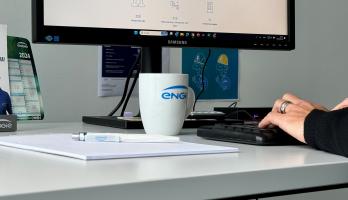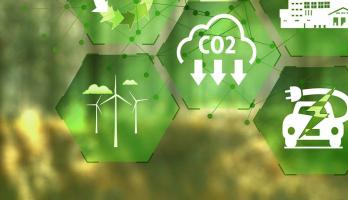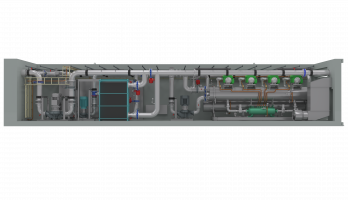‘Chillers with heat recovery are an exceedingly sensible solution’
For which areas are applications with heat recovery suitable? And how does this technology help operating companies lower their costs? Our expert Markus Enzensperger answers these questions in our interview. He also explains the product solutions on offer from ENGIE Refrigeration, and how the QUANTUM Air chiller with optional heat recovery in particular stands out among alternative models in the refrigeration industry.
Mr Enzensperger, what role does the topic of heat recovery currently play in the market?
It is true that demand for refrigeration solutions with heat recovery has increased in recent years. However, I believe the topic is still being underestimated, even though applications with heat recovery offer true added value: operating companies save money and protect the environment. The latter point is the reason why heat recovery is being promoted with attractive subsidies and tax breaks.
Why is heat recovery worthwhile?
All companies that use refrigeration or deep-cooling on an industrial scale generate waste heat. As a rule, this heat is discharged into the outside air and lost. At the same time, every business needs heat for a wide range of applications – to heat buildings, for example, or to heat rain water to a specified temperature. Many companies require heat for their industrial processes. Sometimes refrigeration generates waste heat to such an extent that it could heat an entire housing block. Instead, this heat is generated there by a different method, often even by means of gas burners. And this while the waste heat generated by the refrigeration process has to be re-cooled into the environment in costly fashion and then dissipates, which is a waste of energy. That is why we at ENGIE Refrigeration also use the term ‘energy recycling’ when we talk about heat recovery.
How can users save money with heat recovery?
In fact, the companies operating such systems save money in several ways. First, it lowers investment costs for additional heat-generating subsections or even makes them entirely unnecessary. Second, the overall efficiency of the chiller is improved by utilising the waste heat from the refrigeration process. This lowers energy costs. Over the service life of a system, even minor energy savings can lower operating costs by several hundred thousand euros. At the same time, saving energy always means avoiding carbon emissions. The actual reduction in CO2 depends on the proportion of heat recovery, but it often amounts to several thousand tons of CO2 per year. Companies can thus considerably improve the sustainability of their buildings and production chain.
What heat recovery solutions does ENGIE Refrigeration offer customers?
As part of our ‘zero carbon transition as a service’ strategy, we at ENGIE have made it our business to support our customers on their path to climate neutrality with eco-friendly products and services. Our QUANTUM chillers with heat recovery are an ideal way for us to achieve this aim. The water-cooled series is equipped with a twin condenser, for example, which makes it easy to dissipate the heat from the refrigeration process. And our QUANTUM AIR chillers are also available with green heat recovery (GHR). A GHR condenser can turn some or all of the waste heat into usable heat. ENGIE Refrigeration offers the only air-cooled series in the world with this feature. And I can tell you that we will continue to develop our unique selling point. Soon we will be working as standard with a new compressor that provides higher temperatures than the previous series. New applications for waste heat utilisation will thus become possible, such as preheating service water to a temperature level of 65 degrees Celsius. This will be of interest to many operating companies, especially during refurbishment projects.
What savings does the QUANTUM AIR chiller with green heat recovery deliver?
Let me use an example calculation to illustrate: a version A0570-GHR QUANTUM AIR with a refrigeration capacity of 500 kW requires a wattage of 122.1 kW to operate a chilled water set. This generates 622.1 kW of heat for recovery (EER 4.1/COP 5.1). The electricity costs for continuous operation and 100 per cent load are thus €189,318.00**. If you convert the deployed energy of 622.1 kW heat to a fossil fuel, this results in savings of €386,921.00 per year for natural gas***. The annual savings for heating oil are €550,409.00, while the savings for electricity reach €964,578.00 per year***. In short: the potential savings are huge.
For which areas of application do you recommend chillers with heat recovery?
This ‘networked’ application really is suitable in a great many cases. Heat recovery pays off in particular for all industries that are especially energy-intensive and/or have high demand for heat energy – from producing companies and data centres to hospitals and hotels. We at ENGIE Refrigeration possess extensive experience of all these applications. We have worked with ARBURG, a machine manufacturer in Loßburg; with the Technical University of Munich’s Klinikum rechts der Isar hospital; with Süddeutscher Verlag and with airports. If you want to learn more about the opportunities and advantages of heat recovery, please do get in touch with my colleagues and me.
Mr Enzensperger, thank you for talking to us.
**Assumption: Electricity costs = 17.7 ct/kWh; continuous operation = 8760 h/a
***Assumption: Cost of natural gas = 7.1 ct/kWh; cost of heating oil = 10.1 ct/kWh; electricity cost = 17.7 ct/kWh


